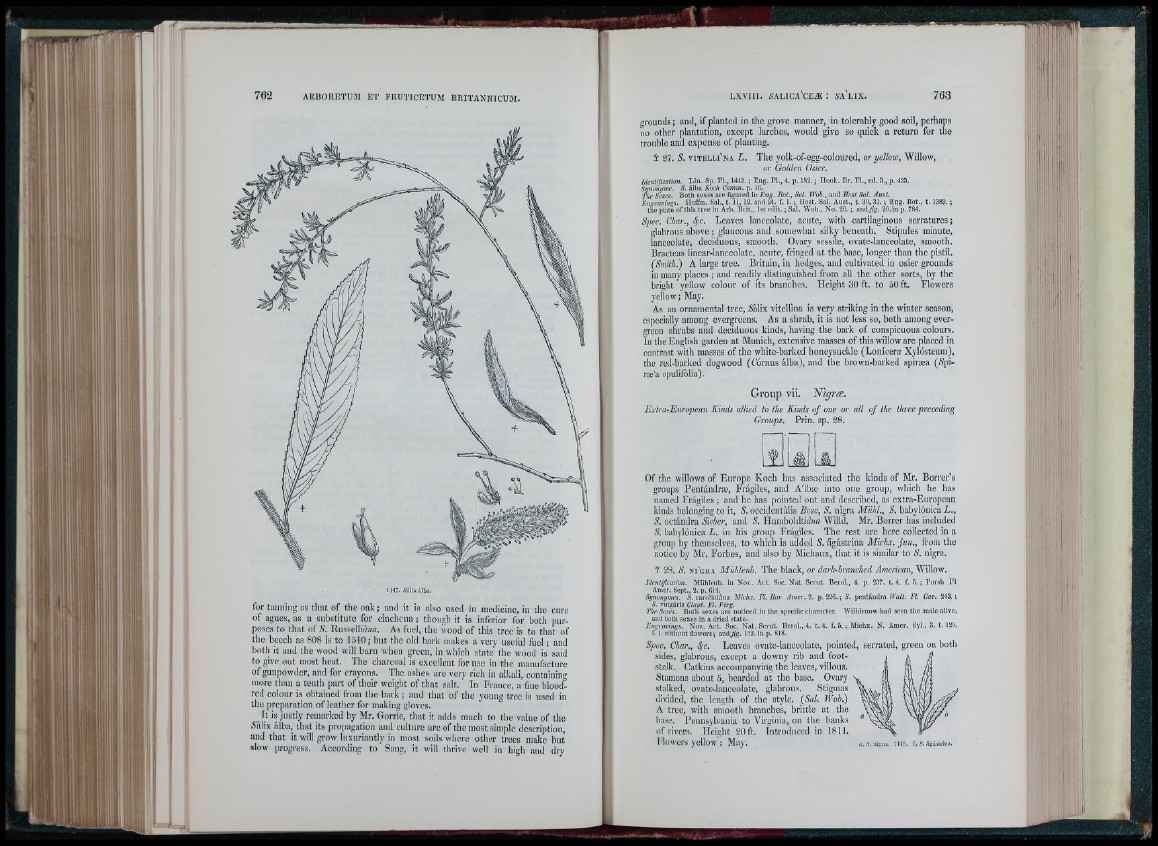
^ ' " "''iii
il ''V
Il 't
!;i;|E
7 6 2 A R B O R E T U M E T F R U T IC E T U M B R IT A N N IC U M .
for tanning as that of the oak; and it is also used in medicine, in the cure
of agues, as a substitute for cinchcna ; tliough it is inferior for both purposes
to that of S. RusselliMcr. As fuel, the wood of this tree is to tiiat of
the beech as 808 is to 1540; but the old bark makes a very useful fuel ; and
both it and the wood will burn when green, in which state the wood is said
to give out most heat. The charcoal is excellent for use in the manufacture
of gunpowder, and for crayons. The aslies are very rich in alkali, containing
more than a tenth part of their weight ofthat salt. In France, a fine bloodied
colour is obtained from the bark ; and that of the young tree is used in
the preparation of leatlier for making gloves.
^ It i,s justly remarked by Mr. Gorrie, that it adds much to the value of the
Nalix alba, that its propagation and culture are of the most simple description,
and that it will grow luxuriantly in most soils wlicre other trees make but
slow progress. According to Sang, it will tlirivc well in high and dry
grounds ; and, if planted in the grove manner, in tolerably good soil, perhaps
no other plantation, except larches, would give so quick a return for the
trouble and expense of planting.
± 27. S. v i t e l l T n a L . The yolk-of-egg-coloured, or yellow. Willow,
or Golden Osier.
Ideitliflealion. Lin. Sp. P l., 1442. i Eng. Fl., 4. p. 182. ; Hook. Br. Fl., ed. 3., p. 423.
Synonyme. S. Slba Kocfi Comm. p. 16.
The Sexes. Both sexes are figured in Fng. Fot., Sal. JVob., and Host Sal. Aust.
Eneravings. IlofTm. Sal., t. 11, 12. and 24. f. 1. ; Host. Sal. Aust., t. 30, 31. ; Eng. Bot., t. 1389. ;
tlie plate ofthis tree in Arb. Brit., 1st edit. ; Sal. Wob., No. 20. ; and/g-. 20.in p. 784.
Spec. Char., 4^. Leaves lanceolate, acute, with cartilaginous serratures;
glabrous above ; glaucous and somewhat silky beneath. Stipules minute,
lanceolate, deciduous, smooth. Ovary sessile, ovatc-lanceolate, smooth.
Bracteas linear-lanceolate, acute, fringed at the base, longer than the pistil.
(Smith.) A large tree. Britain, in hedges, and cultivated in osier grounds
in many places ; and readily distinguished from all the other sorts, by the
bright yellow colour of its branches. Height 30 ft. to 50 ft. Flowers
yellow; May.
As an ornamental tree, ¿àlìx vitellina is very striking in the winter season,
especially among evergreens. Asa shrub, it is not less so, both among evergreen
shrubs and deciduous kinds, having the bark of conspicuous colours.
In the English garden at Munich, extensive masses of this willow are placed in
contrast with masses of the white-barked honeysuckle (Lonicer« Xylósteum),
the red-barked dogwood (C’órnus âlba), and the brown-barked spiræa (¿pi-
ræ'a opulifòlia).
Group vii. Nigræ,
Extra-European Kinds allied to ihe Kinds of one or all o f the three preceding
Groups. Prin. sp. 28.
Of the willows of Europe Koch lias associated thc kinds of Mr. Borrcr’s
groups Pentandræ, Frágiles, and A'Iboe into one group, which he has
named Frágiles ; and he has pointed out and described, as extra-European
kinds belonging to it, S. occidentàlis Bosc, S. nigra Mühl., S. babylónica L .,
S. octandra Sicher, and S. Humboldt¿«na Willd. Mr. Borrer has included
S. babylónica L . in his group Frágiles. The rest arc here collected in a
group by themselves, to which is added S. /igustrina Michx. Jun., from the
notice by Mr. Forbes, and also by Michaux, that it is similar to S. nigra.
¥ 28. S. n i ' g r a Muhlenb. The black, or dark-branched American, Willow.
Identificaiion. Mühlenb. in Nov. Act. Soc. Nat. Scrut. Berol., 4. p. 237. t.4 . f. 5 .; Pursh Fl
Amer. Sept., 2. p. 614.
Synonymes. S. caroliniàna Michx. FL Bor- Amer. 2. p. 226.; S. pentándra Walt. FL Car. 243. ;
S. vulgàris Clai/t. Fl. Virg.
Thc Sexes. Both sexes are noticed in the specific character. Willdenow had seen the male alive,
and both sexes in a dried state.
Engravings. Nov. Act. Soc. Nat. Scrut. Berol., 4. t. 4. f. 5. ; Michx. N. Amer. Syl., 3. t. 125.
f. 1, without flowers ; and/g-. L52. in p. 818.
Spec. Char., 4c. Leaves ovatc-lanccolate, pointed, serrated, green on both
sides, glabrous, except a downy rib and footstalk.
Catkins accompanying the leaves, villous.
Stamens about 5, bearded at the base. Ovary
stalked, ovate-lanceolate, glabrous. Stigmas
divided, the length of the style. (SaL Wob.)
A tree, with smooth branches, brittle at the
base. Pennsylvania to Virginia, on the banks
of rivers. Height 20ft. Introduced in 1811.
Flower.s yellow ; May. «. n. uiKva. ins. ». s.%úsiv¡»n.
ri!;;:!.
rii*;'
"i'lit!
■ ! li